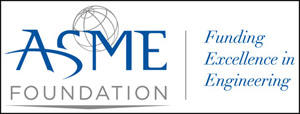ASME Foundation and NASA to Launch “Future Engineers” Program
ASME Foundation and NASA to Launch “Future Engineers” Program

The ASME Foundation has partnered with NASA on a new program that will give K-12 students the chance to design items that could ultimately be manufactured on the International Space Station. Through the new program, “Future Engineers,” the space agency and the Foundation will develop a series of 3D design challenges and curricula intended to inspire students to solve real-world exploration challenges.
For the program’s inaugural challenge, which launches in September, students will be asked to create 3D models specifically designed to be used in space. The winning design will be uplinked to a 3D printer on the International Space Station where the astronauts will print the part. In addition, the winning student will be invited to NASA’s Payload Operations Center in Huntsville, Ala., to watch live as his or her item is printed in space.

Announced last month at the White House Maker Faire, the Future Engineers project was conceived by a small team that included Deanne Bell, a mechanical engineer, ASME member and science, technology, engineering and math (STEM) advocate. Bell, a member of the ASME Foundation’s Board of Directors, came up with the idea for the competition after watching an online video about the 3D Printing in Zero G Experiment, a joint venture between NASA and Made in Space Inc. to launch 3D printing equipment that can operate in microgravity on the space station.
Bell then approached Made in Space and Niki Werkheiser, NASA 3D Printing in Zero-G project manager, with her concept. “Niki embraced my half-formed idea for a single challenge and helped me build it into the Future Engineers inaugural program — a multi-year series of 3D space challenges in collaboration with NASA and the ASME Foundation,” Bell said. “As an ASME member myself, I know that ASME has perhaps the largest network of advanced manufacturing and 3D design experts in the world. It seemed like the perfect fit for a program aimed to teach students how to 3D model their ideas within the context of space manufacturing. The ASME Foundation proved to be a perfect choice, and their enthusiasm for the program was evident from day one. NASA and the ASME Foundation struck a partnership and I'm honored to be working with two of the most respected organizations in the world to inspire young minds.”

Werkheiser, Bell’s Future Engineers collaborator, underscored the importance of encouraging young people’s interest in STEM and aerospace technology in particular. “The students of today are the space travelers of tomorrow,” she said. “It is not someone working at NASA today that will first set foot on Mars. It is a student out there now who is excited about the science fair or designing new Lego creations or practicing for an upcoming math team competition. I can't fathom a better skill to have than to be able to wake up one morning imagining a new tool or part that you need and having the tools at hand to design it on your laptop, print it, and be using it by lunchtime!”
A Zero-G Technology 3D demonstration printer will launch to the station in early fall and will be the first printer to fly in space. It will produce an initial run of space station parts and tools to be tested, as well as print the Future Engineers competition’s winning design. A permanent 3D printer, known as the Additive Manufacturing Facility, is in development and is expected to be installed on the ISS in the future.

Bell noted that the ultimate goal of the program is to connect Future Engineers challenges and curriculum with educators, museums, after-school programs, and maker-capable facilities in local communities. “It's a large endeavor, and the ASME Foundation will need further sponsors and supporters to fully realize these goals,” she said. “If you are interested in becoming an advocate for the program in your community or just want to stay in the know, sign up for our mailing list at www.futureengineers.org.”
The ASME Foundation funds and develops a variety of programs that support and advance the field of engineering. Individuals or companies who would like to support the Future Engineers program financially should contact Dora Nagy at the ASME Foundation by e-mail at nagyd@asme.org. To learn more about the Foundation, visit www.asme.org/about-asme/get-involved/asme-foundation.





